
The Napier Deltic engine is a British opposed-piston valveless, supercharged uniflow scavenged, two-stroke diesel engine used in marine and locomotive applications, designed and produced by D. Napier & Son. Unusually, the cylinders were disposed in a three-bank triangle, with a crankshaft at each corner of the triangle.

The Pegasus-class hydrofoils were a series of fast attack patrol boats employed by the United States Navy. They were in service from 1977 until 1993. These hydrofoils carried the designation "PHM" for "Patrol Hydrofoil, Missile." The Pegasus-class vessels were originally intended for NATO operations in the North Sea and Baltic Sea. Subsequently, participation by other NATO navies, including Germany and Italy, ceased and the U.S. Navy proceeded to procure six PHMs, which were highly successful in conducting coastal operations, such as narcotics interdiction and coastal patrol, in the Caribbean basin.
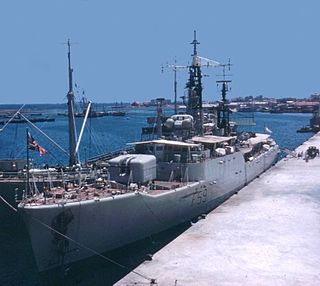
HMS Chichester was a Salisbury-class or Type 61 aircraft direction frigate of the British Royal Navy.
HMS Kirkliston (M1157) was a Ton-class minesweeper of the Royal Navy, built by Harland and Wolff and launched on 18 February 1954. In a brief episode from 1956 to 1960 she was temporarily renamed HMS Kilmorey and was assigned to the Ulster division Royal Naval Reserve (RNR).

A Motor Launch (ML) is a small military vessel in Royal Navy service. It was designed for harbour defence and submarine chasing or for armed high-speed air-sea rescue. Some vessels for water police service are also known as motor launches.
HMS Berkeley was a Hunt-class mine countermeasures vessel of the British Royal Navy. She was sold to the Hellenic Navy in 2001 and was commissioned as HS Kallisto. On 27 October 2020, she was cut in two in a collision with a container ship.

HMS Salisbury was a Salisbury-class or Type 61 aircraft direction frigate of the British Royal Navy. Completed in the late 1950s, Salisbury served through the 1960s and 1970s, participating in the Beira Patrol, blockading against Rhodesia and the confrontation with Iceland over fishing rights that was known as the Cod Wars. Salisbury became a harbour training ship in 1980, before being sunk as a target in 1985.
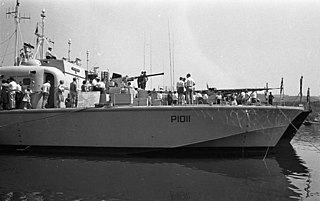
The Brave-class fast patrol boats were a class of two gas turbine motor torpedo boats (MTBs) that were the last of their type for the Royal Navy (RN) Coastal Forces division. They formed the basis for a series of simpler boats which were widely built for export.

The Commandant Rivière class was a class of frigates built for the French Navy in the late 1950s and early 1960s. Labeled "aviso-escorteur", they were designed to perform the role of overseas patrol in peacetime and anti-submarine escort in wartime. This vessel class is named after the French Navy officer Henri Rivière (1827–1883).
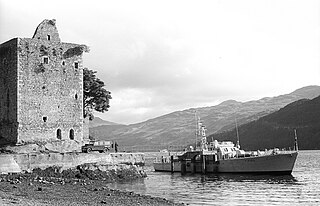
The Ford-class seaward defence boats were built for the Royal Navy in the 1950s.

Coastal Forces was a division of the Royal Navy initially established during World War I, and then again in World War II under the command of Rear-Admiral, Coastal Forces. It remained active until the last minesweepers to wear the "HM Coastal Forces" cap tally were taken out of reserve in 1968. The division received more gallantry awards than any other branch of the Royal Navy during that period.
HMS Iveston was a Ton-class minesweeper of the Royal Navy launched on 1 June 1954 by Philip and Son in Dartmouth. After her decommissioning in 1992, HMS Iveston became the Sea Cadet training ship T.S. Iveston. She was sold and scrapped in March 2015.

The Sparviero class, also known as the Nibbio class, are small hydrofoil missile boats capable of traveling at speeds of 46 knots. They were designed for and formerly used by the Italian Navy. The Japanese 1-go-class missile boat is an updated version formerly used by the Japan Maritime Self-Defense Force (JMSDF).
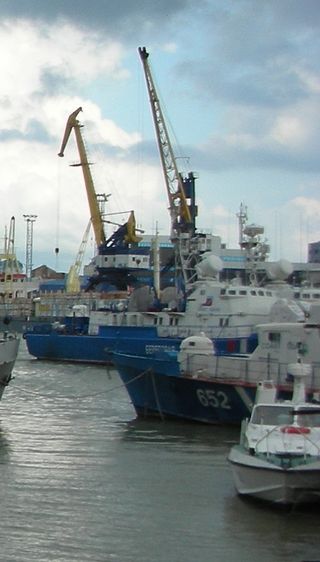
The Muravey-class is the NATO reporting name for a class of hydrofoil patrol boats built for the Soviet Navy between 1983 and 1989. The Soviet designation was Project 133 Antares.

The Gay class were a class of twelve fast patrol boats that served with the Royal Navy from the early 1950s. All were named after types of soldiers or military or related figures, prefixed with 'Gay'. The class could be fitted as either motor gun boats or motor torpedo boats, depending on the type of armament they carried.
HMS Hodgeston was a Ton-class minesweeper which saw service with the Royal Navy during the Cold War. Built by Fleetlands Shipyard, she was launched on 6 April 1954 and broken up in 1988.
HMS Brereton (M1113) was a Ton-class minesweeper of the Royal Navy. Brereton was built by the Lowestoft shipbuilder Richard Ironworks, and was launched in 1953 and entered service in 1954.

The Sa'ar 2 class ("Shalechet") is a class of missile boats built in Cherbourg, France at the Constructions Mécaniques de Normandie shipyard based on Israeli Navy modification of the German Navy's Jaguar-class fast attack craft. Three of the ships class were converted from Sa'ar 1-class patrol boats in 1974.
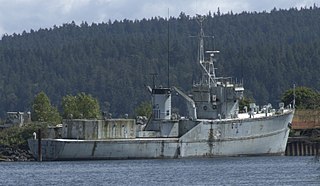
HMCS Cowichan was a Bay-class minesweeper that served in the Royal Canadian Navy during the Cold War. Entering service in 1957, the minesweeper was used primarily as a training vessel on the Pacific coast of Canada. Decommissioned in 1997, the ship was sold in 1999 for conversion to a yacht.
The Scimitar class was a class of three unarmed fast patrol boats operated by the British Royal Navy for the training purposes in the 1970s. They were built by Vosper Thornycroft in 1969 to 1971 and were withdrawn from use in 1981.













